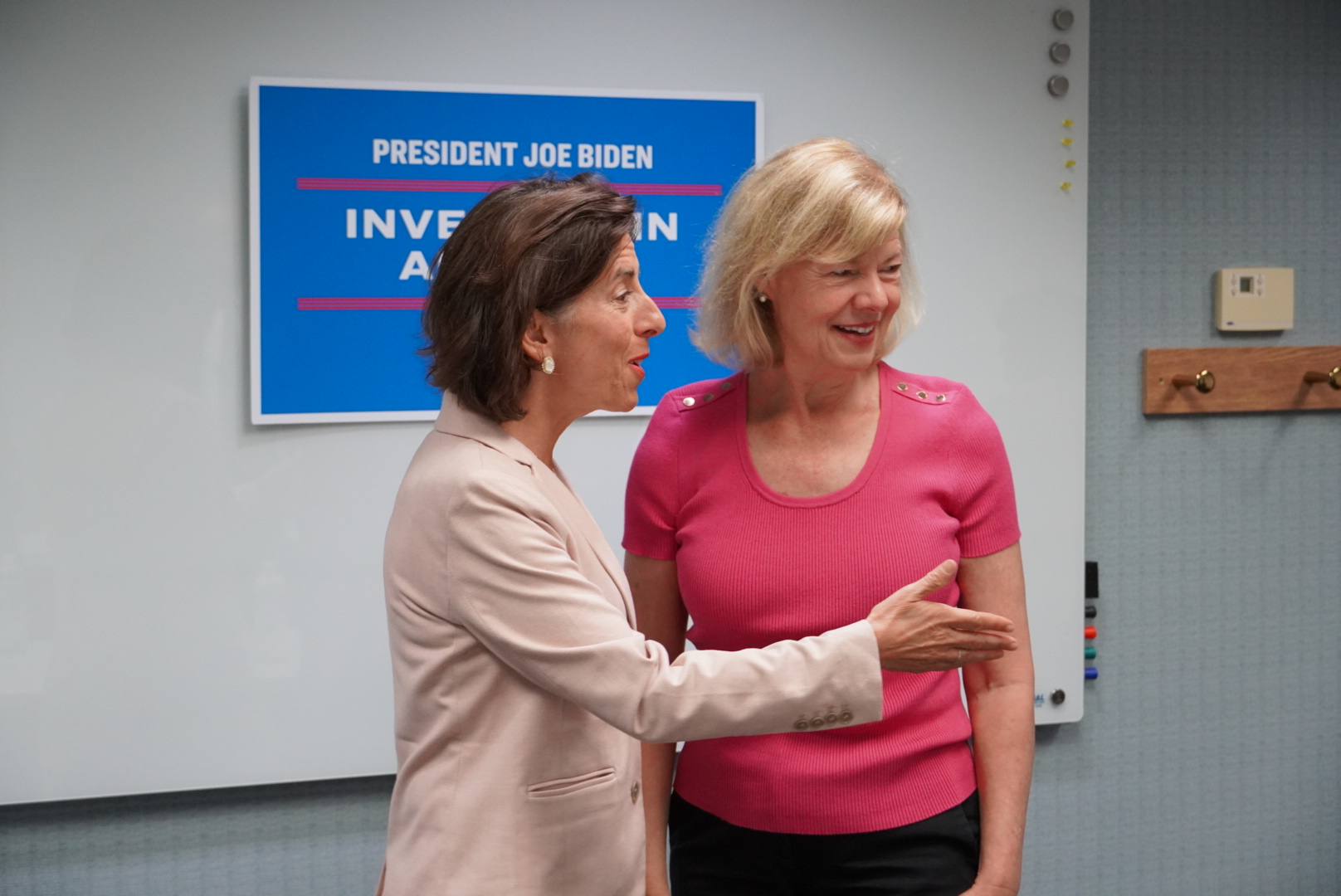How Buy America Helped Create 200 New Infrastructure Jobs in Wisconsin
Share

Biden administration officials traveled to the Badger State last week to announce new broadband electronics production, which came about thanks to Buy America preferences.
Most Americans take their broadband Internet connection for granted. But it is estimated that there are still more than 8.5 million U.S. households and small businesses in areas where there is no high-speed Internet infrastructure.
President Joe Biden promised to expand broadband connection to all Americans by way of the Bipartisan Infrastructure Law. Last week, Vice President Kamala Harris, Commerce Secretary Gina Raimondo, and Sen. Tammy Baldwin (D-Wis.) came together in the Badger State to announce plans from telecommunications giant Nokia to manufacture broadband network electronics in Kenosha County, a step forward in the effort to expand broadband to all Americans.
The new production is set to bring 200 new jobs to the area – and it wouldn’t have happened without Buy America rules included in the infrastructure law.
Nokia, a Finnish company, will manufacture these broadband products through a partnership with the Sanmina Corporation in Pleasant Prairie, Wisconsin.
Most electronic products used in the high-speed Internet industry are currently not made in the United States, but the infrastructure bill included Buy America requirements mandating that federally funded projects use American-made goods whenever possible. Those Buy America requirements extend to the $42.45 Broadband Equity, Access, and Deployment (BEAD) program, which is set to provide $1 billion to Wisconsin to expand high-speed Internet access across the state.
Nokia spent nearly a year and met with Biden administration officials about a dozen times to determine how best to reshore broadband manufacturing in order to meet the Buy America requirements, the Associated Press reported. Ultimately, everything came together.
“President Biden promised to bring high-speed internet to every corner of America and to do it with American workers and Made in America equipment,” said Commerce Secretary Gina Raimondo, whose team led the effort to reshore Nokia production. “This announcement is proof that he’s delivering on that promise.
“When we invest in America manufacturing and American jobs, there’s no limit to what we can achieve. Thanks to the President’s leadership, we’re going to connect everyone in America and create a strong and equitable economy that’s built for the future.”
Today, I was proud to announce that Nokia and Sanmina will expand production in Kenosha County, creating new jobs and building American-made broadband technology as @POTUS and I make historic investments to connect every home in our nation to affordable high-speed internet. pic.twitter.com/qmBFFYqysH
— Vice President Kamala Harris (@VP) August 4, 2023
The announcement by Nokia to manufacture broadband components in Wisconsin could mark the beginning of more telecommunication companies onshoring their manufacturing to the United States. Nokia and Sanmina are showing other manufacturers that it is affordable and makes logistical sense to produce their products locally.
This is Buy America policy at its best. There was a gap in the supply chain for a vital infrastructure need, and the government used procurement preferences to encourage the creation of domestic production to close that gap.
And here’s a key thing about it: It didn’t cost as much as Buy America opponents may have you believe. As the Associated Press reported:
“Critics have said the preferences for American-made supplies would push up costs and cause delays. But Nokia executives said the costs of moving production to the U.S. were relatively small as the major expense for the internet infrastructure involves construction labor and fiber-optic cables.”
Interestingly, Buy America is also encouraging more fiber-optic cable production. Corning, America’s top producer of fiber optic cable, is building a new fiber optic factory in Arizona, and has cited Buy America as the driving force behind that decision.
Nokia, meanwhile, is a top supplier of broadband technology in the United States; Nokia CEO and President Pekka Lundmark said that seven out of 10 fiber connections in North America use Nokia equipment. Given the importance of broadband to our economy and national security, it makes sense that we should want this equipment to be manufactured right here in the United States.
And federal investments should work to encourage such critical manufacturing. Senator Baldwin, a long-time proponent of Buy America, noted that “when we are investing American taxpayer dollars, we should be supporting American workers, American businesses and the American economy.”
“In Wisconsin, we make things. We have a long and proud manufacturing history, and I am thrilled that with today’s news, that legacy will continue into the future,” Baldwin said in a statement. “As we rebuild our nation’s infrastructure, Wisconsin has the world-class research institutions, a robust Made in Wisconsin manufacturing economy and the skilled workforce to get the job done.
“I was proud to support the Bipartisan Infrastructure Law and fight for strong Made in America requirements so that as we are investing taxpayer dollars in our roads, bridges, water infrastructure and broadband we are also supporting Wisconsin businesses, Wisconsin workers and the Wisconsin economy.”
Vice President Harris toured the Sanmina factory during her visit, and said in remarks after the tour that “whereas in the past, many of those jobs would have been created overseas, President Biden and I required that the materials and products used in these projects, from steel to electronics to fiber optic cable, must be made in America, by workers in America.”
In doing so, not only does Buy America support good job creation and local economies, but it also will ensure that the United States is able to manufacture the things we need – and lessen our reliance on imports for critical goods. And Americans certainly need Internet access.
“In America in the 21st century, high-speed Internet is not a luxury,” Harris said. “It is a basic necessity.”
